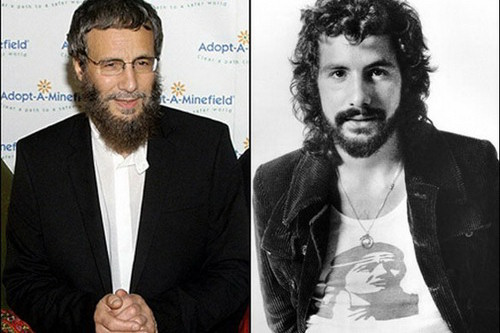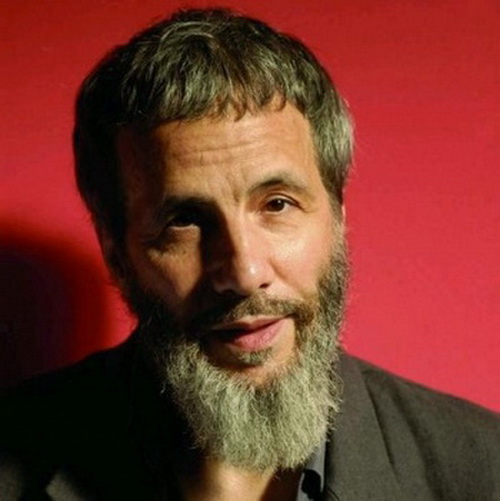Stefanos Georgiou, either as Cat Steven, either as a Yusuf Islam, has passed into the pantheon of illustrious and important songwriters of our World Music.

Stefanos - Demetrios Georgiou was born in London on July 21, 1948 and was the third child of Greek Cypriot Stavros Georgiou (1900) and Swedish women Ingrid Wickman (1915). The parents of Stephen, who had a restaurant in London, divorced when he was 8 years old, but continued to work together in the restaurant and most of the songs of Stephen who-actually-are small poems, distinguished a complaint regarding family relationships.
He was a successful musician, singer and songwriter and became known as Cat Stevens. The albums Tea for the Tillerman (1970) & Teaser and the Firecat (1971), became three times platinum while Catch Bull at Four (1972) sold one million copies its first two weeks of release.
In December 1977, Stevens converted to Islam, changed his name to Yusuf Islam (1978), sold all his guitars at auction and gave all the money he got for charitable purposes (1979). For they indeed charitable activities, was awarded and still awarded even today.
*** Cat Stevens (1948-1978)

Despite the religious "differences" that had the Orthodox father of the Lutheran mother, Stephen was sent to St. Joseph Roman Catholic Primary School and there was interested to learn piano. But with the popularity of the Beatles, saw opportunities for the guitar and convinced his father to buy him his first guitar in 1965. His interest in music was originally directed to Greek songs he had learned from the environment of his father, but the main influences on future career, was by Bob Dylan & Paul Simon.
In Mona Bone Jackson, dealing with death (and survival), apparently influenced by the
adventure that went with tuberculosis and the first single that came out of this album, was the "Lady D'Arbanville" which sounded very much the American and British radio. The Cat wrote this song for the American actor and his girlfriend, Patti D'Arbanville. Other songs written for her and found in Mona Bone Jakon, is "Maybe You're Right" & "Just Another Night". In "Pop Star" recounts his experience as a star and "Katmandu" playing the flute Peter Gabriel. The Mona Bone Jakon made him very popular, but it was only the precursor to the international climax came the next year with the Tea for the Tillerman.
In Mona Bone Jackson, dealing with death (and survival), apparently influenced by the
adventure that went with tuberculosis and the first single that came out of this album, was the "Lady D'Arbanville" which sounded very much the American and British radio. The Cat wrote this song for the American actor and his girlfriend, Patti D'Arbanville. Other songs written for her and found in Mona Bone Jakon, is "Maybe You're Right" & "Just Another Night". In "Pop Star" recounts his experience as a star and "Katmandu" playing the flute Peter Gabriel. The Mona Bone Jakon made him very popular, but it was only the precursor to the international climax came the next year with the Tea for the Tillerman.
Stephen started playing in small pubs with the name Steven Adams (1966), because, he said, was unthinkable to ask the albums with the name Stephen - Demetrios George, but ultimately chose the Cat Stevens as a friend , said he is "feline" eyes. That same year, attracted the interest of the producer Mike Hurst and just the single "I Love My Dog" featured in stacharts No 28, while "Matthew and Son" & "I'm Gonna Get Me a Gun" was in British Top 10.
In December 1967 the album New Masters failed to sales, but was notable in history for the song "First Cut Is the Deepest" which became a huge success with Rod Stewart (1977) and Sheryl Crow (2006). The arrangement is the Sheryl Crow gave him the award for "Songwriter of the Year" (2006)
Meanwhile, the failure of the sales of New Masters did the producer Mike Hurst not want to continue in the same style of music and proposes a rich and "heavy" arrangement for the next album of Cat, but who "liberated" more than Deram's contract but also from tuberculosis, he made an audition with Chris Blackwell's Island, which offered him a new contract "to record his songs whenever he wants and as he wants." This really liked the Cat (and who would not like?) And took Paul Samwell-Smith (bassist Yardbirds), for a new producer signing along with the Island in 1970. Meanwhile, the American A & M's Jerry Moss was interested in the Cat and so, very quickly to the intake (from PaulSamwell-Smith) of the virtuoso guitarist Alun Davies, started the recordings of Mona Bone Jakon. The acquaintance of the Cat & Alun evolved into a powerful friendship that lasts until today.
The folk-rock style with lyrics reflection of everyday life, interspersed with "a life" spiritually unanswered questions of mankind, will find from now on all Cat's albums . Many songs stood out through the Tea for the Tillerman, but the premier was "Wild World" which he wrote for the "departure" of D'Arbanville by their relationship. Chris Blackwell of Island said it was the best album ever released (until then it means). In 2001, the album won the multi-platinum and the list of "500 Greatest Albums of All Time" in Rolling Stone Magazine featured in No 203.
Teaser and the Firecat released shortly after the Tea for the Tillerman, and it contained a remarkable songs like "Peace Train", "Morning Has Broken" & "Moon Shadow".
Since 1971-and 7 months-until 1972, Cat has created a beautiful romance with Carly Simon which developed singing dialogue.
Carly Simon, Wrote for Cat the "Legend in Your Own Time" & "Anticipation" and the Cat replied with "Sweet Scarlet" located on Catch Bull at Four, 1972.
Intermediate or simultaneously with these albums, Cat recorded in July 1970, "But I Might Die Tonight" for the film Deep End of Jerzy Skolimowski and 1971 put 9 songs on the soundtrack of the black comedy Harold and Maude. Among them the famous "Where Do the Children Play?", "Trouble", "I Think I See the Light", "Don't Be Shy" & "If You Want to Sing Out, Sing Out". The last two were not in any of the album until 1984 included in the Footsteps in the Dark: Greatest Hits, Vol. 2.
In 1972 comes the Catch Bull at Four. His voice here is more cruel, the less acoustic album, does not make any special success, but nevertheless, there is gold in 15 days.
But success is not ongoing. The Foreigner in 1973 actually marks his retirement from the music scene. Cat goes from Britain for tax reasons and goes to Rio de Janeiro. Records where the Foreigner without Samwell-Smith and he does not play guitar, but keyboards. The album contains 4 tetralepta pieces and a multilateral 18lepti suite. Only "Hurt" was singled out by it all, but generally did not go well at all. The Foreigner came recently in the news acting as a source of inspiration for Viva La Vida of Coldplay.
The next thing was the Buddha and the Chocolate Box and was a return to the sound of Teaser and the Firecat & Tea for the Tillerman, marked the return of Alun Davies and became known for "Oh Very Young". The Numbers, however, that immediately followed, or what went wrong.
Cat makes virtually his last success with the "Remember the Days of the Old Schoolyard" inside the Izitso of 1977 and in late 1978 released the Back to Earth is his last album under the name Cat Stevens.
Decca, Islands and Cat himself , released several collections of greatest collections of 1975 & 1984 Greatest Hits (Vol. 1 & 2) and the Ultimate Collection 2003.
*** The Transformation
1976 in a visit to Morocco has its first contact with Islam and in the summer of that year again faces death. Specifically, was about to drown while swimming in Malibu and in despair whispered: "God save me and I will serve all my life." As he says, immediately after the plea, a huge wave grabbed him and brought him back to shore. This incident impressed him very much and in conjunction with the study of the Koran (which he made a gift by his brother for his birthday), he found the tranquility that sought enosis. Studying the Koran, was impressed by the story of Joseph sold by his brothers on the market, likened by his "sale" in the music industry and so slowly, began the transformation. In an interview with Alan Yentob in 2006, said that in Islam finally found his spiritual home was searching all his life.
*** Yusuf Islam (1978 - 2010)
So we lost Cat, but we found Yusuf. To see the formula. The entrance to Islam was officially on December 23, 1977 and took the name Yusuf (Arabic version of the name Joseph) Islam in 1978. Before leaving his music career, he made one last appearance at Wembley on November 22, 1979 at a charity concert for UNICEF, together with David Essex & Alun Davies.
Yusuf Islam, therefore, married Fauzia Mubarak Ali on September 7, 1979.
This marriage, brought him even closer to Islam. They have 5 children together, living in London, but spend some time of their time in Dubai.
As we saw, once became a Muslim, he abandoned his music career, which stated to the Imam to receive the answer that was wrong has left the musical scene since the moral content of his songs were accepted by the world. Yusuf (now), retorted that the "temptations" of being a pop star, is too many for sustainable them and not consistent with the teachings of the Koran. In an interview with Jools Holland ,27 years later, he said: "People love me but I did not have a personal life and I was always in search."
It is estimated that his music career as Cat Stevens, to yield about $ 1.5 million annually and Yusuf decides to use that money to charities. In 1981, founded the North London the Islamia Primary School and soon after, followed by other Muslim schools in different areas. In 1992, proclaimed himself president in all Muslim schools in Britain and is also the chairman of Small Kindness Charity that supports thousands of orphans in the Balkans, Indonesia and Iraq. He has also served as chairman of Muslim Aid Charitable Foundation from 1985 until 1993.Suddenly, even though she had left the music scene, decided in 1985 to appear in the Live Aid concert held in Ethiopia, even writing a song for the occasion, but his appearance was canceled at the last minute because Elton John who played before him, he played a long time.
On September 21, 2004 while he was on a flight from London to Washington, his name was mentioned, the plane landed in Bangor, where he was received by the security and the next day, the "came back" to London. The Israelis accused of funding the Palestinian Hamas organization of the Americans forbade the entry into the U.S..
In October 2004 the British newspaper Sun & Sunday Times claimed the ban imposed by the Americans in Yusuf and accused him of being sponsor of terrorist organizations. Yusuf responded with a lawsuit and indicated that mistook the Yusuf Islam with Yussef Islam which was the name of an Arab terrorist. The result was a win financial compensation and apologies of the newspaper were forced to say that there was never sponsor of terrorists and also did not know how he had been given the award for Man of Peace by the Nobel Peace Prize Laureates Committee. Yusuf said that the moral damage suffered, not be repaired by all the money in the world and donated the financial compensation to the victims of the tsunami in the Indian Ocean.
This adventure, lasted nearly 2 years, ending in December 2006 when he was allowed to enter the U.S.. But he did not forget and never do much good to report it to the song "Boots and Sand" written in the summer of 2008, but in an article published in newspapers entitled: "A Cat in a Wild World".
In the 90's, returned to discography and musical events persuaded by his friends and also his son, who brought suddenly at home a guitar and Yusuf took his hands and began to play. That was enough to return. He built his own studio named Mountain of Light Studios and records where the most new jobs in the released with his own company "Majicat."
Despite all the problems at times (actually it is) the political establishment, the charity and charities are not missing from his life. Very often participates in charity concerts and donated the copyright of the discs for orphan children around the world.
The current sound, approaching the sound of "Tea for the Tillerman" period and this is very interesting, because just like any case, either as Stefan George or Cat Stevens as Yusuf Islam, has passed into the pantheon of illustrious and important songwriters of the world of music.
1967: Matthew & Son
1967: New Masters
1970: Mona Bone Jakon
1970: Tea for the Tillerman (*****)
1971: Teaser and the Firecat
1972: Catch Bull at Four
1973: Foreigner
1973: Buddha and the Chocolate Box
1973: Numbers
1974: Saturnight (Live)
1975: Greatest Hits (Collection)
1977: Izitso
1978: Back to Earth
1984: Footsteps in the Dark: Greatest Hits, Vol. 2 (Collection)
1987: Classics, Volume 24 (ECR)
1989: The Best of Cat Stevens (ECR)
1999: The Ultimate Collection (Collection)
2000: The Very Best of Cat Stevens (ECR)
2001: Cat Stevens - The Box Yet (ECR)
2004: Majikat (Live)
2005: Gold (ECR)
2007: Harold and Maude (Soundtrack)
*** Discography (Yusuf Islam)
1995: The Life of the Last Prophet
1998: I Have No Cannons that Roar
1999: Prayers of the Last Prophet
2000: A Is for Allah
2001: Bismillah
2002: In Praise of the Last Prophet
2003: I Look I See
2003: Night of Remembrance
2005: Indian Ocean
2006: Footsteps in the Light
2006: An Other Cup
2008: I Look, I See 2
2009: Roadsinger
*** Bibliography / Sources
1: Encyclopedia of Rock & Roll (Rolling Stone)
2: Illustrated Encyclopedia of Rock (Salamander)
3: Encyclopedia of Pop, Rock & Soul (Irwin Stambler)
4: A Musical Journey (Bob Harris)
5: Behind the Music (Jim Forbes)
6: Biography & Discography (George Brown)
7: Cat Stevens (Tom Farncombe)
8: www.majicat.com
9: www.yusufislam.org.uk
Then...
geofront88
.....and Now !!!!
terminal2020
by Orfeus
http://www.musicheaven.gr/html/modules.php?name=News&file=article&sid=2944
friendliness participation in the translation of texts
Michael Balaroutsos architect



